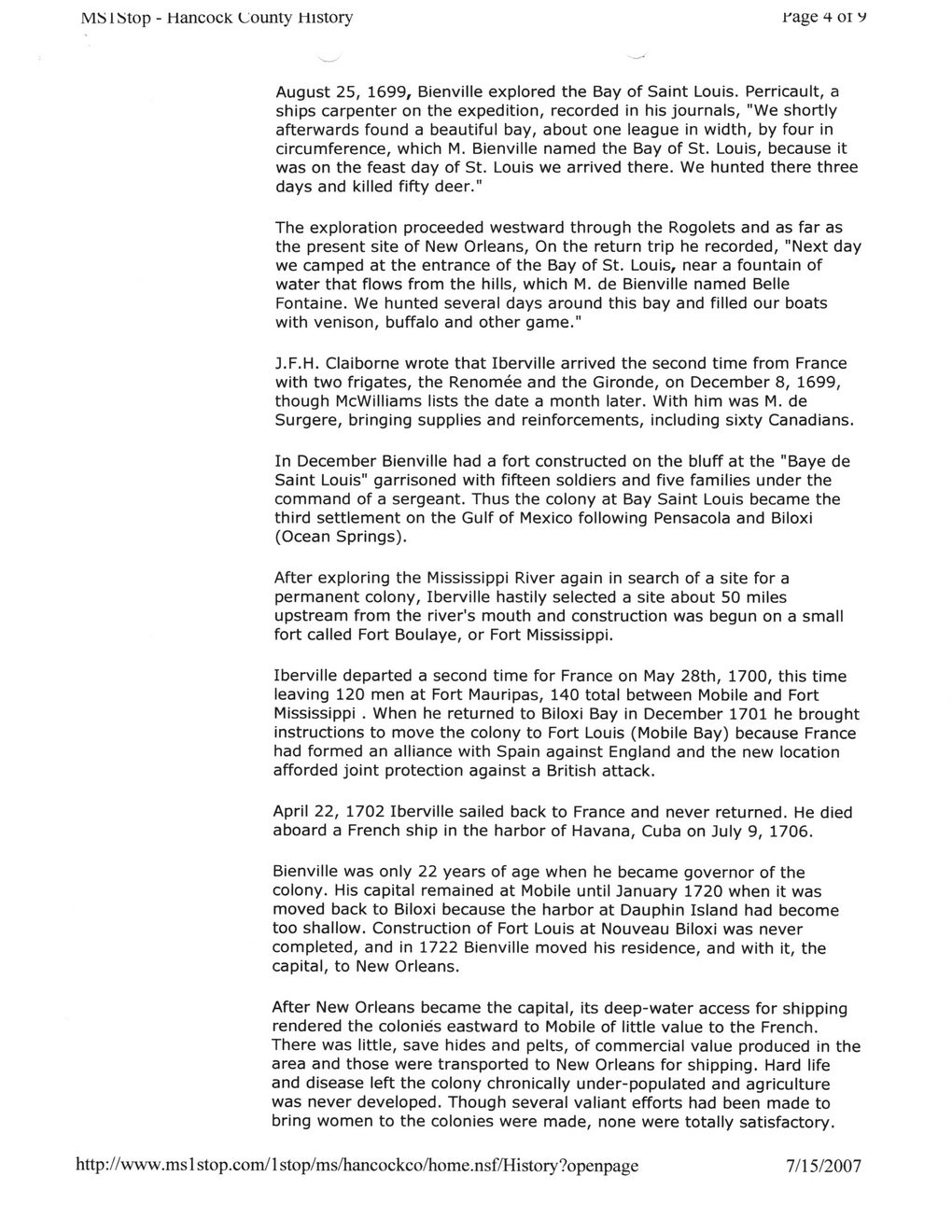This text was obtained via automated optical character recognition.
It has not been edited and may therefore contain several errors.
MS 1 Stop - Hancock uounty History i^age 4 or y August 25, 1699, Bienville explored the Bay of Saint Louis. Perricault, a ships carpenter on the expedition, recorded in his journals, "We shortly afterwards found a beautiful bay, about one league in width, by four in circumference, which M. Bienville named the Bay of St. Louis, because it was on the feast day of St. Louis we arrived there. We hunted there three days and killed fifty deer." The exploration proceeded westward through the Rogolets and as far as the present site of New Orleans, On the return trip he recorded, "Next day we camped at the entrance of the Bay of St. Louis, near a fountain of water that flows from the hills, which M. de Bienville named Belle Fontaine. We hunted several days around this bay and filled our boats with venison, buffalo and other game." J.F.H. Claiborne wrote that Iberville arrived the second time from France with two frigates, the Renomee and the Gironde, on December 8, 1699, though McWilliams lists the date a month later. With him was M. de Surgere, bringing supplies and reinforcements, including sixty Canadians. In December Bienville had a fort constructed on the bluff at the "Baye de Saint Louis" garrisoned with fifteen soldiers and five families under the command of a sergeant. Thus the colony at Bay Saint Louis became the third settlement on the Gulf of Mexico following Pensacola and Biloxi (Ocean Springs). After exploring the Mississippi River again in search of a site for a permanent colony, Iberville hastily selected a site about 50 miles upstream from the river's mouth and construction was begun on a small fort called Fort Boulaye, or Fort Mississippi. Iberville departed a second time for France on May 28th, 1700, this time leaving 120 men at Fort Mauripas, 140 total between Mobile and Fort Mississippi . When he returned to Biloxi Bay in December 1701 he brought instructions to move the colony to Fort Louis (Mobile Bay) because France had formed an alliance with Spain against England and the new location afforded joint protection against a British attack. April 22, 1702 Iberville sailed back to France and never returned. He died aboard a French ship in the harbor of Havana, Cuba on July 9, 1706. Bienville was only 22 years of age when he became governor of the colony. His capital remained at Mobile until January 1720 when it was moved back to Biloxi because the harbor at Dauphin Island had become too shallow. Construction of Fort Louis at Nouveau Biloxi was never completed, and in 1722 Bienville moved his residence, and with it, the capital, to New Orleans. After New Orleans became the capital, its deep-water access for shipping rendered the colonies eastward to Mobile of little value to the French. There was little, save hides and pelts, of commercial value produced in the area and those were transported to New Orleans for shipping. Hard life and disease left the colony chronically under-populated and agriculture was never developed. Though several valiant efforts had been made to bring women to the colonies were made, none were totally satisfactory. http://www.ms 1 stop.com/1 stop/ms/hancockco/home.nsf/History?openpage 7/15/2007

Hancock County A-Touch-of-History-(4)